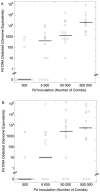Host, pathogen, and environmental characteristics predict white-nose syndrome mortality in captive little brown myotis (Myotis lucifugus)
- PMID: 25409028
- PMCID: PMC4237369
- DOI: 10.1371/journal.pone.0112502
Host, pathogen, and environmental characteristics predict white-nose syndrome mortality in captive little brown myotis (Myotis lucifugus)
Abstract
An estimated 5.7 million or more bats died in North America between 2006 and 2012 due to infection with the fungus Pseudogymnoascus destructans (Pd) that causes white-nose syndrome (WNS) during hibernation. The behavioral and physiological changes associated with hibernation leave bats vulnerable to WNS, but the persistence of bats within the contaminated regions of North America suggests that survival might vary predictably among individuals or in relation to environmental conditions. To investigate variables influencing WNS mortality, we conducted a captive study of 147 little brown myotis (Myotis lucifugus) inoculated with 0, 500, 5000, 50,000, or 500,000 Pd conidia and hibernated for five months at either 4 or 10°C. We found that female bats were significantly more likely to survive hibernation, as were bats hibernated at 4°C, and bats with greater body condition at the start of hibernation. Although all bats inoculated with Pd exhibited shorter torpor bouts compared to controls, a characteristic of WNS, only bats inoculated with 500 conidia had significantly lower survival odds compared to controls. These data show that host and environmental characteristics are significant predictors of WNS mortality, and that exposure to up to 500 conidia is sufficient to cause a fatal infection. These results also illustrate a need to quantify dynamics of Pd exposure in free-ranging bats, as dynamics of WNS produced in captive studies inoculating bats with several hundred thousand conidia may differ from those in the wild.
Conflict of interest statement
Figures




References
-
- Blehert DS, Hicks AC, Behr M, Meteyer CU, Berlowski-Zier BM, et al. (2009) Bat white-nose syndrome: an emerging fungal pathogen? Science 323: 227–227. - PubMed
-
- Meteyer CU, Buckles EL, Blehert DS, Hicks AC, Green DE, et al. (2009) Histopathologic criteria to confirm white-nose syndrome in bats. Journal of Veterinary Diagnostic Investigation 21: 411–414. - PubMed
-
- Lorch JM, Meteyer CU, Behr MJ, Boyles JG, Cryan PM, et al. (2011) Experimental infection of bats with Geomyces destructans causes white-nose syndrome. Nature 480: 376–378. - PubMed
-
- Carey HV, Andrews MT, Martin SL (2003) Mammalian hibernation: cellular and molecular responses to depressed metabolism and low temperature. Physiol Rev 83: 1153–1181. - PubMed
-
- Bouma HR, Carey HV, Kroese FG (2010a) Hibernation: the immune system at rest? J Leukoc Biol 88: 619–624. - PubMed
Publication types
MeSH terms
Substances
LinkOut - more resources
Full Text Sources
Other Literature Sources
Medical

